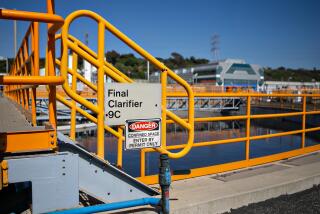Thinkers Are Flush With Toilet Ideas
Is anything low-tech anymore? Not in this bells-and-whistles nation, where--you can bet on it--someone, somewhere, is at this moment picking up a fork and referring to it as “a multi-tined ergonomically parabolic food retrieval system.”
Americans can’t leave anything alone. This is both good and bad. On the one hand, we have the evolution of the bathing suit from 20 pounds of ruffles and bloomers to .03 ounces of Spandex. On the other, we have the devolution of coq au vin to Chicken McNuggets.
We tinker, and nothing, not one single object, no matter how mundane, pragmatic or generally overlooked, can escape. We tinker with solid fuel Space Shuttle boosters, but we also tinker with toilets.
Yes. The porcelain-and-plumbing crowd has, over the years, managed to turn something that was once about as low-tech as cutting a half moon in the door with a keyhole saw into a minor marvel of physics and design.
At its most basic, the 20th-Century indoor-plumbing toilet is very basic indeed: Water held in a tank is released into a bowl below it, washing waste down a drain. The principle is simple gravity. And in the first indoor toilets, this principle worked beautifully, thanks to the fact that the tank was situated high on the wall above the bowl. By the time the water reached the bowl, a good amount of what is called “head pressure” had accumulated and the bowl was washed thoroughly clean.
This arrangement still works well, and the old “pull-chain” type of toilet still is used in homes when the owner wants to achieve a rustic or old-fashioned decorator look.
There is, however, a trade-off: This sort of toilet takes up a large amount of vertical space, uses a lot of water, and is noisy. It is precisely these drawbacks that the most modern toilets are designed to eliminate.
The biggest change in toilet design in recent years lies in its use of water, said Rich Haagsma, owner of Faucets n’ Fixtures, a bath and kitchen supply store in Orange. Before the early 1960s, Haagsma said, toilet tanks routinely used seven gallons of water per flush. In the early ‘60s, federal law mandated a five-gallon maximum, which was reduced to 3.5 gallons in the late 1970s. After 1994, Haagsma said, the volume will be reduced yet to 1.5 gallons. There are even some toilets on the market today that operate on 1.1 gallons, he said.
This saves water, and water bills (Haagsma said that estimates have placed the percentage of water used by the average household toilet at as much as 40% of total household water usage), but creates certain physical and mechanical problems.
They can be solved in three ways, Haagsma said. The first method involves a small canister inside the tank that allows the pressure from the water line leading into the house to power the water into the bowl, creating sufficient head pressure. Institutional toilets, such as the ones in airport restrooms where no tank is visible, work on this principle, he said. The drawback: Home models are just as noisy as the airport models.
The second method employs a mechanism in an otherwise common-looking tank (raised slightly, and containing a larger water volume) that allows use of only the top few inches of water in the tank, leaving the rest untouched. That water is expelled at the bottom of the bowl rather than the top, where it creates the necessary siphon effect with sufficient head pressure. But this, too, can be noisy.
The final method is quiet, but can be less efficient. The water is pumped through its cycle by an electric motor and a 1/2-inch water line. This arrangement is used in the so-called one-piece “low-boy” toilets, in which the tank and low-slung bowl are contained in a single piece of porcelain.
The “low-boy” toilet is the choice of new homeowners and homeowners who want to remodel “by far,” said Tim Lowry, the showroom manager of Familian Bath and Kitchen Center in Costa Mesa.
The main reason, he said, is the sleeker, more modern-looking design. They are, however, more expensive than the more familiar two-piece toilets. While two-piecers can cost from around $90 to $400, Haagsma said, one-piecers can run from $225 to around $1,100.
That, however, is not the end of the American high-tech toilet. More tinkering is going on. One major toilet manufacturer, Kohler, is offering a flushing mechanism called the Peacekeeper. It consists of a magnet embedded in the toilet seat lid. When the lid is up, the magnet and a magnetic sensor in the tank “touch” to create a magnetic field. When the lid is closed, the magnetic field is broken and the flushing mechanism (which is battery operated) is triggered automatically.
Next: the hands-free talking toilet that reads your newspaper to you. Count on it.






